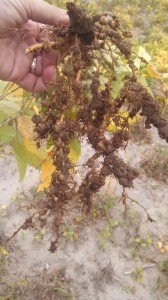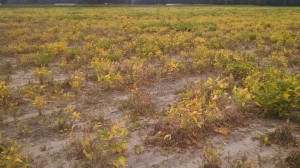I have had nematodes on my mind throughout our cropping season. Seems that sometimes we forget those pesky roundworms can ruin an otherwise good year. A colleague at University of Georgia, Rome Etheridge, recently shared a post on Seminole Crops E-News about both cotton and peanuts with nematode problems. Perhaps I haven’t looked closely enough at the cotton, but we have struggled this year in corn, then soybeans, and finally peanuts with nematode problems this year. I shared links to Mr. Etheridge’s work where he has provided good information and to recognize these nematode issues are regionally important.
We are struggling to develop crop plans for 2015 that include negative margins and we will be facing difficult decisions about high input costs and low commodity prices this winter. I’m certain we will have some frank discussions about the profitability of some cropping systems/operations this winter and nematode pressure is a major factor in this discussion.
We have perennial issues with nematodes of all “shapes and sizes” in our corn crops, particularly where we have long-term corn production in the rotation. We have tried to address issues with the corn crop by using Counter 15G insecticide. Farmers and researchers alike report consistent results with the use of Counter 15G in corn production.
We learned a lot about nematodes in soybeans this year. Some have embraced soybeans as an economic salvation, which could be easily plugged into the cropping systems of the region and be profitable with lower inputs per acre. Root-knot nematodes revealed locally there is “no free lunch.” The included pictures are of root knot nematode damage on soybeans in Columbia County. The farmer has utilized this farm for years for continuous corn production for a specialty/niche grain and ear corn operation. We observed the knotty roots just a couple weeks into the season. However, we were quite surprised to learn the corn history would harbor that level of root knot nematode populations. Without control measures such as resistant varieties, soybeans appear to be “off the table” for much of our local farmland in future years, regardless of prices.
Many area farmers have installed irrigation and adopted a corn-peanut rotation in the last decade. This has proven effective and efficient on “new land.” The run-up in corn prices began in 2006, and peanuts became more widely planted following the end of the quota system in 2003. The timing of policy and markets were a much larger factor in this adoption than ideal agronomics. I mention this to say as much of this land approaches 5 peanut crops in 10 years we are beginning to see more issues with root-knot nematodes in our “go-to” cultivar, 06-G. Many farmers depend on the high yield potential of 06-G’s, but the nematode pressure is growing each year on this farmland and the corn/peanut rotation may not be an economically sustainable short term or long term option.
Much more troubling are our local issues and concerns with the Tifguard cultivar of peanuts, which are a natural fit for the corn/peanut rotation. Tifguard is identified as having “near-immunity” to peanut root-knot nematode. However, we have been hearing reports of nematode damage by root-knot nematodes on Tifguard peanuts in Levy County for several years. Dr. Dickson, Professor at UF Nematology Department has been studying this issue, however I have not heard with clarity what is scientifically occurring. I mention this to say that we seem to be “growing” our own local popluation of root knot nematodes that feed on Tifguards now. I have identified one field in Suwannee County which we knew had a history of high nematode populations prior to planting peanuts in 2014. This land was in sorghum in 2012 and corn in 2013. We hoped the combination of crop rotation and Tifguards would offer high peanut yields, but the nematodes appear to think differently.
Unfortunately, I can’t identify what the take home message is from this post. Undoubtedly, we all have economic concerns with our cropping system into the future. Perhaps the message I would like to share is that I also have major agronomic concerns.



Yes, Mace, nematodes are sometimes unnoticed yield robbers at low levels and then with time and crop choices, become apparent. Better to find them early on so plans can be made.
One of the students at uf did a paper on nematodes. There a way of keeping them under control. Look up cover crops of mustard, rape, kale etc. The student told how to use the above.
Thanks Chester, We are going to be planting some rape this winter on some of this land. Mustards look better, but seed is very expensive for large acreage.